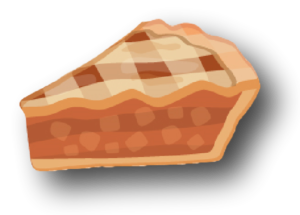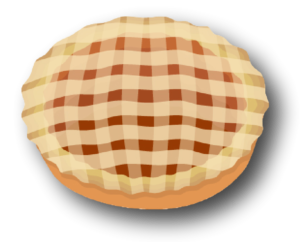Historic PIE Recipes: Old-Time Favorite
Nothing quite says Old-Time cooking like homemade pie. Real pie–with crust made of lard (or butter) and flour, filling made of berries or mincemeat or pumpkin off the vine. I’ve already shared an article about the 19th Century American traditions of Thanksgiving, plus a vintage pie crust recipe (with images of historic pie safes), and now I’d like to share some historic pie recipes that were originally published in the Prairie Farmer magazine between the years 1841 to 1900. A compilation of these historic recipes from Prairie Farmer are in paperback book format in A Prairie Kitchen, compiled by Rae Katherine Eighmey and published in 2001.
I’ll also share a truly old-fashioned cream pie recipe, strategies by historic bakers to keep cream pies from soaking the crust, and a lemon pie of days gone by. All of these came from 19th century newspapers. Citations provide information as to year, location, and specific newspaper name.
PORK PIE, MEAT PIE, CHICKEN PIE…
I’ll save these delicacies (main dishes) for another day. This article will focus on dessert pies.
PUMPKIN PIE
The almost universal mode in New England of preparing pumpkin for pies (a kind that is universally admired) is that of stewing the pumpkin after it has been cut in pieces and passing it through one of two other processes before it is in a state for baking–thereby making much labor. I think a more preferable mode of preparation and one which I believe will be highly valued by all housewives, is that of grating the pumpkin; after grating add the milk, eggs &c., in the same proportions as usual. Your domestic readers will find that pies made this way are equally nice and even more delicate with one-third the labor. ~ The North Hampton Courier, February 1844
.
November 1852:
Rub lard on pie plate. Sprinkle with dry corn meal. Put in prepared pumpkin. “Bake quick and you will have a nice pie.”
.
PIE PLANT PIE
I recall reading about Laura Ingalls Wilder having made a pie of “pie plant“, forgetting to sweeten it, and in her mortification, the guests at her dinner table made some kind remark about “now everybody can sweeten his own to his own taste”, and lifting the crust to sprinkle sugar from the sugar-bowl on the table. Which of the various Little House on the Prairie books that may have been, I don’t recall. But I do remember considering what “pie plant” may have been and coming up with no answers.
Do you know?
The following recipe’s instructions are obviously modernized, but the ingredients are apparently true-to-history. If the instructions were 1866-style, it would speak of a “quick oven” instead of 425 degrees F.
Pie Plant, no. 1
Pie Plant Pie (Rhubarb) ~ April 21, 1866
Crust for a two-crust pie, 8-inch
2 cups rhubarb (sliced in 1/4-inch or smaller slices)
2 cups boiling water
2 tablespoons butter
2 tablespoons flour
1/2 teaspoon nutmeg
3 or 4 tablespoons sorghum
.
Put the thinly sliced rhubarb in a heatproof container and pour the boiling water over it. Let it stand until the water is cold, 20 minutes or so. Preheat the oven to 425 degrees F. Drain off the rhubarb water (you may reserve it to make Rhubarb Lemonade by combining with 1/4 cup lemon juice and sugar to taste.) Pat the rhubarb dry and place in pie pan lined with the bottom crust. Dust with flour and nutmeg, and dot with butter. Drizzle the sorghum over the top evenly. Top with upper crust, sealing the edges and cutting slits for the juices to vent. Bake for 15 minutes at 425 degrees F., then lower the oven to 350 degrees F. and continue baking until the crust is golden and the juices have begun to bubble, about 30 minutes longer.
.
Editor’s Note: This is a real pioneer pie, using two of the most readily available prairie ingredients–rhubarb and sorghum. Rhubarb has commonly been called “pie plant” since colonial days. By blanching the rhubarb, you remove some of the bitterness, so you need less sweetening. If you don’t care for the taste of sorghum or molasses, you might try making it with corn syrup.
.
.
Pie Plant, No. 2
.Rhubarb Pie Plant — June 20, 1885
.
In new counties and on new farms where fruit is scarce, there is nothing else that can so nearly take its place as the stalks of the rhubarb plant. If good roots are set out, and it often yields quite well even the first year, as I proved by experience last season. And the second spring it will be just in its prime.
.
It requires a good deal of sugar when cooked, as it is so strongly acid, but as that is the only expense incurred by its use, it is not extravagant, especially in these days when sugar is so cheap. It comes so early in the spring before any fresh fruit is to be had, except at exorbitant prices for that which is shipped from the South or California. A moderate use of it cooked in different ways, is really healthful, I think.
.
CREAM PIE (and Cheese Pie–it’s not cheesecake…)
Old-fashioned cream pie is perhaps my absolute favorite of all historic pie recipes. Sweet, smooth, creamy, and delicious when drizzled with thinned raspberry pie filling, crushed fresh berries, or other similar topping.

Cream Pie Recipe (and Cheese Pie Recipe) found in The Pittsburgh Press of Pittsburgh, Pennsylvania, on August 13, 1900.
“JUMBLE” RECIPE, KEEP CUSTARD OR CREAM PIE FROM SOAKING THE CRUST, AND LEMON PIE RECIPE

Jumble Recipe, prevent soaked crust, and Lemon Pie Recipe, published in Chicago Tribune of Chicago, Illinois, on May 18, 1878.
LEMON PIE
LEMON PIE.
To the Editor of The Tribune.
My mother’s recipe, and a very excellent one, I think:
1 cup sugar; 1 cup sweet milk; grated rind of 1 lemon; the yolks of 4 eggs, beaten with the juice of lemon; the whites beaten separately, with which a little white sugar may be added; the whites and sugar to be laid over the pie when nearly baked. Mrs. A. H. H.
~ Chicago Tribune, August 5, 1876

.
Which of these historic pie recipes surprised you? Which interests you most? (as in I’d order a slice at my favorite “prairie schooner-type” restaurant. Please scroll down and contribute to the discussion. Thanks!
.
Related Articles
Updated May 2021
Copyright © 2016 Kristin Holt LC








































I’ll get back to you when I’ve baked the cream pie and the lemon pie, but these look like exactly what I’ve been looking for! Very interesting that to keep these pies from softening the crust, add a teaspoon of baking powder to the crust recipe.
I’d like your comments on adding a teaspoon of vinegar to egg whites for meringue; opinions vary.
Please do, C. Landridge–
Let me know your feedback when you’ve made these vintage recipes for cream pie and lemon pie.
I don’t know a thing about adding vinegar to egg whites for meringue. I’ve made meringue before, with modern recipes, but have no recollection of using vinegar. Keep searching! =)
Happy Baking,
Kristin